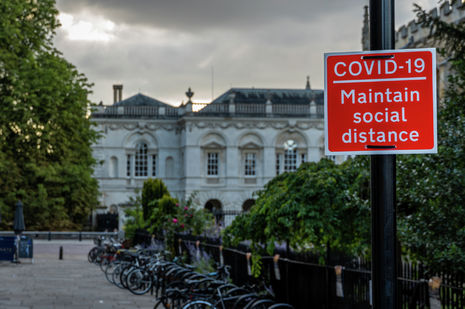Breaking: Cambridge University to remain open as the government announces month long lockdown
Unlike the last lockdown, educational institutions will remain open

The government announced a month long national lockdown this evening (31/10) as cases across the country continue to rise, surpassing even the projected worst case scenarios.
The lockdown, which will come into force next Thursday (5/11), will be very similar to the UK’s first lockdown except that educational institutions, including the University of Cambridge, will be allowed to remain open.
During the news briefing the Prime Minister stressed that education is the government's priority.
Bars, pubs, restaurants will all be forced to close. Households will not be allowed to mix inside although people will be allowed to meet up with an individual from one other household outside.
The lockdown will last until December 2nd, only two days before Michaelmas full term officially ends.
In the news briefing announcing the lockdown, Chris Witty, England's Chief Medical Officer, shared graphs which showed how rates of Covid-19 are spread throughout age groups, having first become prevalent among the young.
Sir Patrick Vallance, the government's Chief Scientific Advisor, further warned that the R value, which indicates the virus's rate of infection, has been above the critical value of 1 for at least a month now and continues to grow.
Vallance further shared graphs from different groups of academics who modelled death rates over the winter; these graphs showed the potential for the death rate to be twice as high compared to the ‘first wave’ of the virus. Vallance stressed that if nothing is done projection models predict that death rates will increase over the next six weeks.
In response to this announcement, the University and College Union (UCU) said “It would be incomprehensible if universities were allowed to continue to do this (in-person teaching) after the outbreaks we have seen on campuses across the country this term.”
“Ministers must tell universities to move all non-essential in-person teaching online as part of any national lockdown.”
The government’s announcement comes as the number of new Covid-19 cases in Cambridge approaches 200 per 100,000 residents per week.
On Friday (30/10), Dr Liz Robin, the Public Health Director for Cambridgeshire County Council, asked residents of Cambridgeshire and Peterborough to avoid mixing households indoors.
“I would advise people to really think about inviting people they don’t live with around to their homes, because that is something that really drives transmission of the virus,” she said in a television interview with ITV.
The infection rate in Cambridge, at 193.9 per 100,000, exceeds that in Luton, which is entering Tier 2 of the Government’s hierarchy of restrictions this weekend.
At present, the number of new cases in Cambridge is highest among young people.
“In Cambridge City we know that the sharpest rise in the rate of infection has been among the younger age group, particularly 18-24 year olds and that the proactive testing programme for Cambridge University students has contributed to this,” noted Robin in an earlier interview with Cambridgeshire Live.
Cambridge MP Daniel Zeichner, in response to news of a national lockdown, commented: “As soon as Keir Starmer saw the evidence he called for a short circuit breaker over half term to fix testing. I called for Cambridge to move to Tier 2. The Tories blocked it. But now because the Government were too slow to act we face a much harder lockdown. That will be worse for people’s health and jobs. That’s been the story throughout this crisis - a government that’s too weak to too slow. When will they ever learn?"
He continued: "If we do face more restrictions then the Government must this time fix test and trace and get a proper plan in place so fewer people suffer.”
Cambridgeshire County Council, meanwhile, has issued advice to “inspire residents to try an alternative approach to a ‘spooktacular’ Halloween”.
The Council recommends “spooky snacks at home”, a “scary film night”, or making a “Halloween themed face covering” as alternatives to trick-or-treating, which is discouraged.
The number of coronavirus cases continues to rise across the UK, with the latest analysis suggesting there were between 43,000 and 74,000 new infections per day in mid-October.
 News / Clare Hall spent over £500k opposing busway 24 December 2025
News / Clare Hall spent over £500k opposing busway 24 December 2025 News / Caius mourns its tree-mendous loss23 December 2025
News / Caius mourns its tree-mendous loss23 December 2025 Comment / The ‘class’ of Cambridge24 December 2025
Comment / The ‘class’ of Cambridge24 December 2025 Comment / Yes, I’m brown – but I have more important things to say22 December 2025
Comment / Yes, I’m brown – but I have more important things to say22 December 2025 Interviews / Politics, your own way: Tilly Middlehurst on speaking out21 December 2025
Interviews / Politics, your own way: Tilly Middlehurst on speaking out21 December 2025









